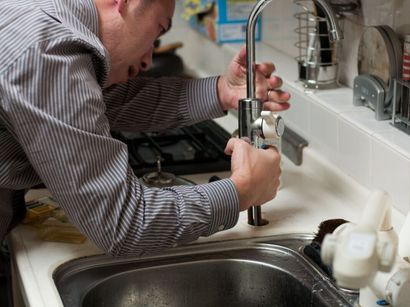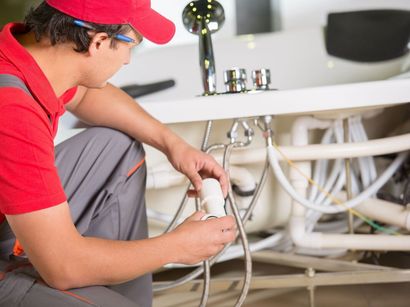As the #1 at Plumbing in Lawton OK, we understand when you need plumbing installations or repairs, you definitely don't want to wait. Whether you've got an unexpected leak that needs to be detected or repaired, or you've got a scheduled kitchen or bathroom remodel, we know the importance of a quick & reliable contractor. The most difficult thing about typical house
Schedule Evaluation TODAY!
Lawton Plumbing Service
maintenance repairs is getting ahold of a good contractor that does all the things they say they're going to do. Answer their phone. Show up on time. Finish when they say they're going to finish. Stay under budget. We take extra ownership & special pride in our services because we know plumbing emergencies are more severe than other maintenance emergencies around the house. Water and moisture are especially harmful to homes and building. Because moisture is not always easily detected and can hide under the house or in walls for many months or years, it can cause long term damage to the home or building. It's vital that you contact us when you think you might have any potential leaks or water issues. Be sure to find us under plumbers near me on google.

* Indicates required field


Plumbing Lawton OK
PLUMBER NEAR ME
When picking a plumber in Lawton OK, it's important to make sure you're working with one that has a wide range of knowledge & experience. We've worked on every type of residential plumbing service job you can imagine. Everything from burst pipes gushing water into a home owner's living room to beautiful million dollar home renovation & new construction. No matter the project, our licensed & bonded contractors will exceed your expectations every time. Below are the top notch services that we provide.
Emergency Leak Services can be the worst of all emergencies in the home. Not only do you have to repair the damaged plumbing material, but you also run the risk of damaging everything else near the leak. When you have any leak, whether it's a small leak under a sink or a major burst pipe repair, you need to act immediately and call us TODAY. We will instruct you how to alleviate the immediate issue by turning off the water supply to your home and then one of our licensed & bonded technicians will be there within 24 hours.
Hot Water Tank Installation & Repair is a small piece of the overall plumbing puzzle, but a vital one for sure. Let's be honest, in this day and age we need hot water in our house. Whether you need the hot water to clean your house, or just clean yourself, when you want it, you WANT IT. When you find your water heater is not adequately heating your water, there can be many potential problems. Some as simple as your pilot light being out, some more complicated such as a small mechanical part not operating properly, and some much more severe like the water heater needing replaced entirely. Call our licensed and bonded plumbers to come and evaluate your issue today. Another commonly overlooked aspect of the plumbing puzzle is compliance to the municipal code that regulations your city. When installing or repairing plumbing features in your home, you want to make sure the work is done properly and inspected by the appropriate governing bodies.
Annual Hot Water Tank Maintenance might be one of the most overlooked aspects of your home. Everyone knows that you need to change the filters to your Heating & Air system, and unhook your water hose from the spigot outside in the winter, and various other annual maintenance items, but very few people understand the importance of your annual water heater maintenance.
Shower & Tub Installation is a simple, but not always easy process. We offer full service shower installation and bathtub installation. You just buy the product and we'll deliver it and install it. You can do pre-built shower or tub inserts or you can do just the tub or shower pan and we can partner with our trusted vendor, Tile installers Denver, to install the tub or shower tile surround. We love providing easy, turn key solutions.



Plumbing Fixture Installation can be a simple and inexpensive way to spruce up your bathroom or kitchen. New fixtures are like a facelift to an existing sink or bathtub. You can add these on top of a total bathroom remodel or kitchen remodel or just make it an easy weekend project.
Water Line & Drain Line Repair
are important to preventing any supplemental water damage. The water lines are the lines that supply water to your fixtures & appliances. There can be no room for error with water lines since the supply lines stay full with water all the time. Any leak or loose fitting can cause leaks & subsequent damage.
Sewer Line Inspection & Repair can be costly, but is an important process. If you are noticing slow draining or gurgling in any of the drains in your house, it could be evidence of damaged, leaky, or collapsed sewer lines. You need to contact a us immediately because the longer the problem exists, the more supplemental damage the issue can cause.
Leak Detect & Slab Leak Repair
can be a very destructive and expensive issue to fix. The longer this issue exists, the more supplemental damage it can cause. We use out cutting edge technology to identify and locate any slab leaks and then we work as fast and as soft of we can to fix the issue before it causes anymore damage to your house.
New Construction Installation should be quick and simple when using the right plumbing lawton company. There's an old adage that goes: "When you do things right, people won't be sure you've done anything at all". That's especially true with plumbing. If we do our job like we're supposed to, you should never have to think about plumbing problems. We begin before the foundation is poured and we don't stop until the final plumbing fixture is installed on your beautiful new home. From beginning to end, we work hard to make sure you have no problems at all with your plumbing for many many years to come.
Gas Line Installation & Repair
is very important to the safety of your home and your family. Gas, like water, can find even the smallest of cracks and can leak. Gas leaks can be more dangerous since you can't see them. You can usually identify gas leaks by their district smell. Natural gas itself is odorless, so producers of natural gas have added a harmless gas called mercaptan which gives it a rotten egg odor. If you smell this, contact us right away.



Tips for Plumbing Lawton OK
Below are a couple quick tips for hot topics when it comes to plumbing requests or issues.
Frozen Water lines- Prevention is the best measure when it comes to frozen water lines. There are several preventative measures when it comes to frozen water lines. The first and most common is to drip your faucets. This means barely turn on the cold water faucet so a little water drips out. This will cause the water to be constantly moving in the water line which will lessen the likelihood of the line freezing. Second, we recommend you open

the cabinet doors under all your sinks. The allows the warmer air from the room to get underneath the sink and warm the water lines up from the outside. This can slow down and /or prevent the line from freezing. Freezing is most common when the water line if on an exterior wall. The best thing you can do is make sure the line is insulated inside the wall to slow down or prevent the line from freezing. However, since you're reading this now, we will assume the lines have already frozen. If you're lucky, the lines are simply frozen and not actually burst. If the line is simple frozen you'll want to do two things. First, open the faucet to the water can escape as it starts to thaw. Secondly, expose the line to a heat source as quickly as possible to it does not continue to expand and then burst. If the water line is under a sink you can simply open the cabinet doors and hopefully expose it to the warmer air of the room. You can maybe even use a hair dryer if you want to speed up the process. If the frozen water line is in a wall, especially an exterior wall, and the outside
temperature will not be heating up anytime soon, it might be worth it to cut a hole in the wall to expose the frozen pipe so it does not stay frozen and continue to expand and eventually burst. If this is the issue, it is best to get with a plumbing lawton ok professional so we can cut the wall in the right place and not cause any other damage to any other systems that might be in your wall. While it's exposed, it is a great opportunity to properly insulate the lines after they have thawed.

Hot Water Tank Maintenance - Hot water tanks are an integral part of any home's plumbing system, and regular maintenance can help prevent issues and extend their lifespan. By following a few simple steps, you can ensure efficient operation, reduce energy costs, and avoid costly repairs or replacements. Regular maintenance is so important because it significantly extends the lifespan of your hot water tank. Over time, sediment and minerals can accumulate at the bottom of the tank, leading to corrosion and reduced efficiency. By taking proactive measures, you can prevent these issues and keep your tank functioning optimally for years to come.
Proper maintenance ensures that your hot water tank operates efficiently. Sediment buildup can act as an insulator, making it harder for the heating element to heat the water effectively. By removing sediment and performing routine checks, you can maintain optimal performance and ensure an adequate supply of hot water.
A well-maintained hot water tank operates more efficiently, resulting in lower energy costs. When sediment accumulates, it forces the tank to work harder to heat the water, consuming more energy in the process. By regularly maintaining your tank, you can reduce energy consumption, save money on utility bills, and contribute to a greener environment.
To keep your hot water tank in good condition, regular inspection and cleaning are crucial. Here are some essential steps to follow:
Checking for Leaks and Corrosion
Inspect your hot water tank for any signs of leaks or corrosion. Check the pressure relief valve, connections, and pipes for any visible leaks. If you notice any issues, it's important to address them promptly to prevent further damage.
Flushing the Tank
Sediment can accumulate at the bottom of the hot water tank over time, affecting its performance. Flushing the tank periodically helps remove this sediment and keeps the tank running smoothly.
To flush the tank, follow these steps:
- Turn off the power supply to the hot water tank.
- Locate the drain valve at the bottom of the tank and attach a hose to it.
- Place the other end of the hose in a drain or outside where the water can safely flow.
- Open the drain valve and allow the water to flow out until it runs clear.
- Close the drain valve and remove the hose.
- Turn on the power supply and allow the tank to fill up again.
By regularly flushing the tank, you can prevent sediment buildup and maintain efficient operation.
